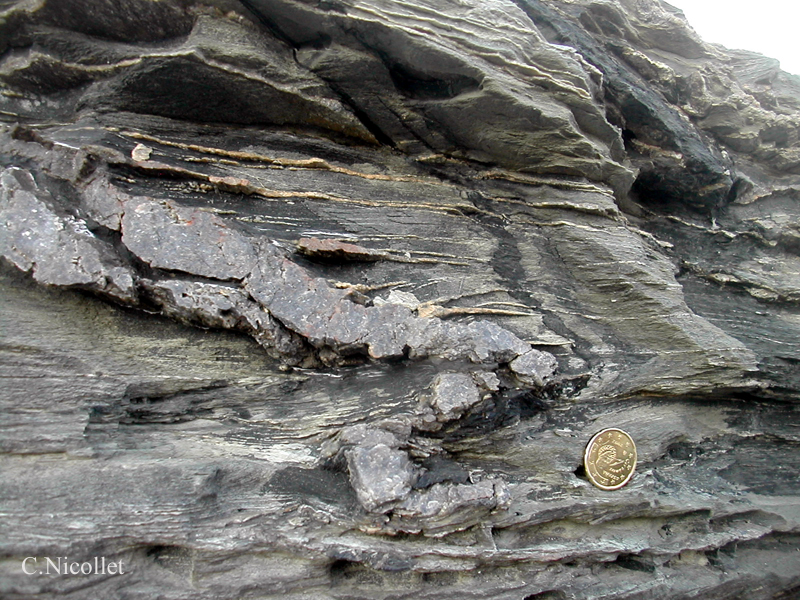Is metamorphism isochemical?
As a first approximation, we consider that metamorphism is isochemical, i.e. it is not accompanied by changes in the chemical composition of the rocks. Such approximations are common in the so-called natural sciences! Only in the case of "obvious" chemical changes is the term metasomatosis or metasomatism used.
However, it is worth noting that metamorphism is isochemical, except for the fluids.Indeed, one definition of metamorphism states that it is a process of dehydration (or more generally devolatilization). But in this case, the water that circulates during this dehydration is, without any doubt, not pure, but dissolves many elements!
Exudation quartz
The"Schistes des Cévennes" are a major formation in the south-east of the french Massif Central.

These are weakly metamorphosed in the early GreenSchists facies conditions and show lenses of exudation. These lenses are generally arranged in the plane of the schistosity, as can be seen by approaching the outcrop a little closer:
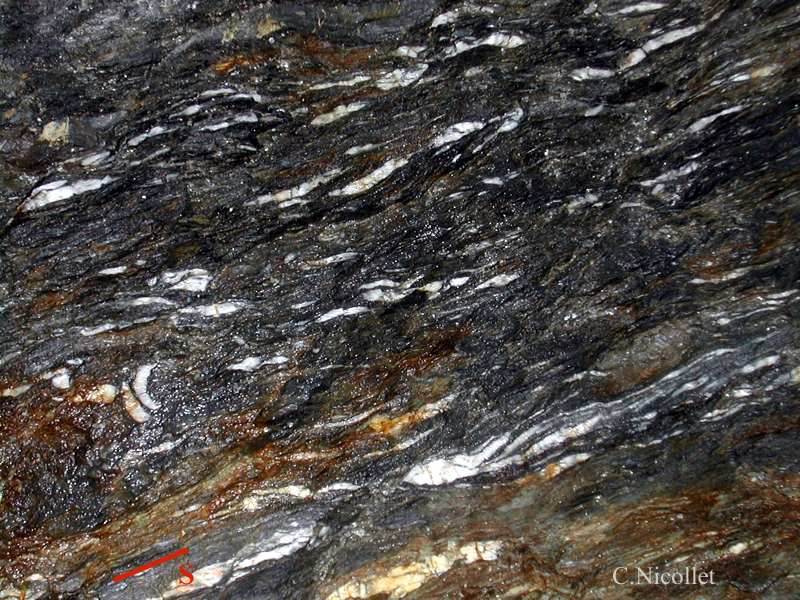
But they are sometimes folded or oblique to the foliation and stratification, as in the picture below. This indicates that these lenses were formed continuously during the deformation process.
|
Move the mouse over the picture to see the interpretative drawing In this drawing, the folded stratification is shown in black; it is formed by a sandstone-pelitic sequence whose colour varies in the greys. The exudation quartz is shown in yellow with a red rim. The green dashed line represents the fold of the large quartz lens. We notice that this lens and the stratification are both folded, but secant to each other. This suggests that this quartz was formed when the layering began to be deformed. LThe small quartz levels, concordant with the schistosity (which is horizontal and axial plane of the fold) were formed later. This demonstrates the continuous development of this quartz in the plane of the schistosity during deformation.
This quartz is linked to deformation and metamorphism. In the greenschist facies conditions, water released by the metapelites is abundant. It moves up from the depth to the surface. At depth, this water has dissolved certain elements such as silica. Indeed, the solubility of elements in water increases with temperature and pressure (i.e. depth).
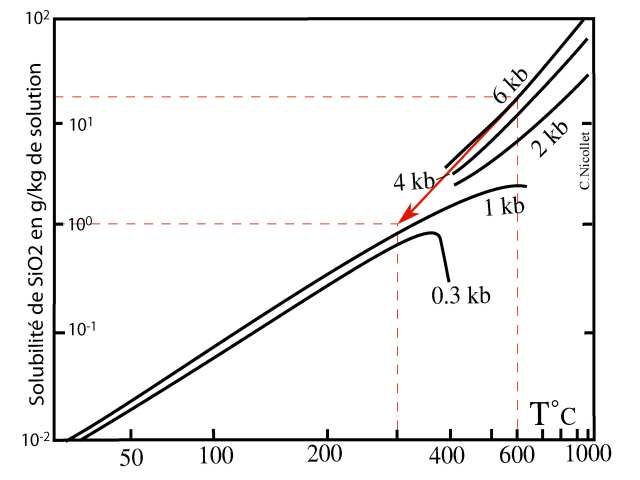
Solubility of silica as a function of temperature and pressure. (note: the scales are logarithmic). The solubility depends little on pressure up to a temperature of 400°C.
As a result, the solubility of elements decreases as this water rises to the surface. In the figure above, the red arrow shows the silica content in water released from a rock at 6kb - 600°C and which would rise again at 2kb - 300°C. The concentration varies from 15g/kg-solution to 1g/kg: during this cooling-exhumation process, the water, saturated in silica, precipitates the quartz. This is the way these quartz lenses are formed; their large volume in these "Schistes des Cévennes" testifies to significant transfers of material.
If metamorphism can be considered as isochemical, it must be forgotten that it is an approximation ...
But where does silica come from? Tectonic (or metamorphic) layering and transposition
On this non-metamorphic shale, a sedimentary bedding (red segment) can be seen dipping to the right. This bedding is highlighted by thin, clear millimetric levels, rich in quartz in a dark matrix rich in clay minerals. The rock is crossed by a horizontal penetrative schistosity (yellow segment). It appears that this schistosity materializes a bedding, i.e. delimits levels of different lithologies...

This sample is 4.5 cm long. The red segment is parallel to the trace of the stratification and the yellow segment is parallel to the trace of the schistosity. The blue rectangle locates the microphotograph below.
Let's look under the microscope what happens in the blue rectangle. The photo below is taken at the intersection of the sedimentary bedding and the tectonic bedding materialized by the schistosity. The stratification (in red) is locally folded (called "crenulated"). The tectonic layering is marked by a high proportion of light minerals (quartz)/dark minerals (clays) in the zone where the stratification is crenulated.
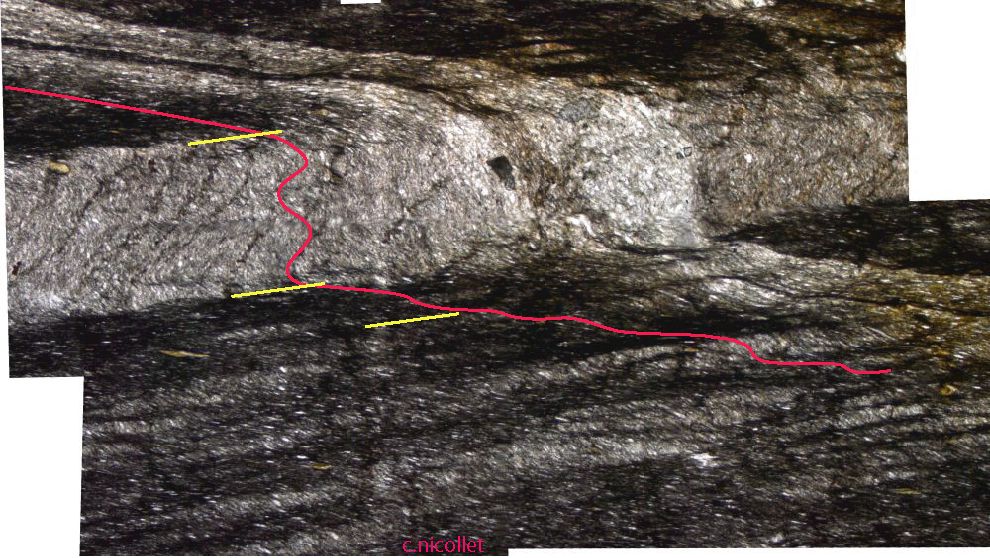
The wide side of the photo is about 0.5 cm; PPL.
The deformation at the origin of the microfolding is also the cause of the schistosity-litage by differential dissolution of quartz (among others?), preferentially on the flanks of the folds, i.e. where the angle between the stratification and the schistosity is the lowest. The process induces chemical changes in the rock; dissolved elements precipitate nearby or much further away where they feed the exudation quartz.
This process has two major consequences:A new bedding is created in the rock, which will gradually become more and more important while the sedimentary bedding tends to disappear. A transposition of surfaces is taking place. The orientation of this new layering is completely independent of that of the sedimentary bedding!
It is easy to conceive that such a mechanism can bring significant chemical changes to the rocks. There is no doubt that silica is not the only mobile element. As an example, here is a calculation proposed by Etheridge et al (1983) of changes at the microscopic scale:
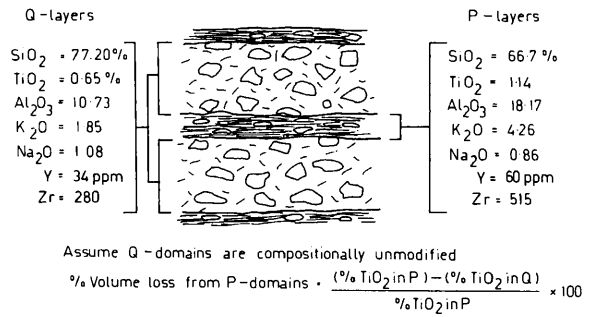
Tectonic (or metamorphic) layering should not be confused with a paleostratification!
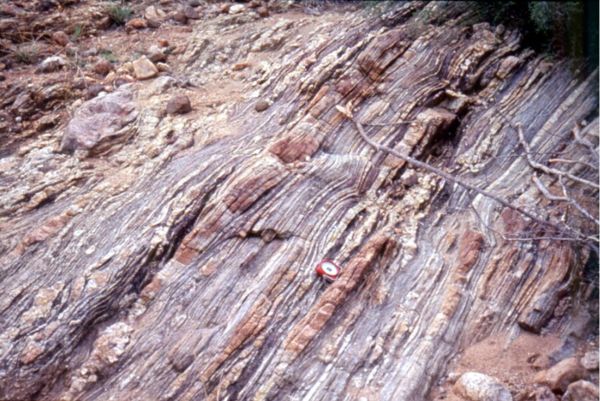
 Back to the PhotoGallery, to the Metamorphism Course or else to the Home Page ? Back to the PhotoGallery, to the Metamorphism Course or else to the Home Page ?
|


